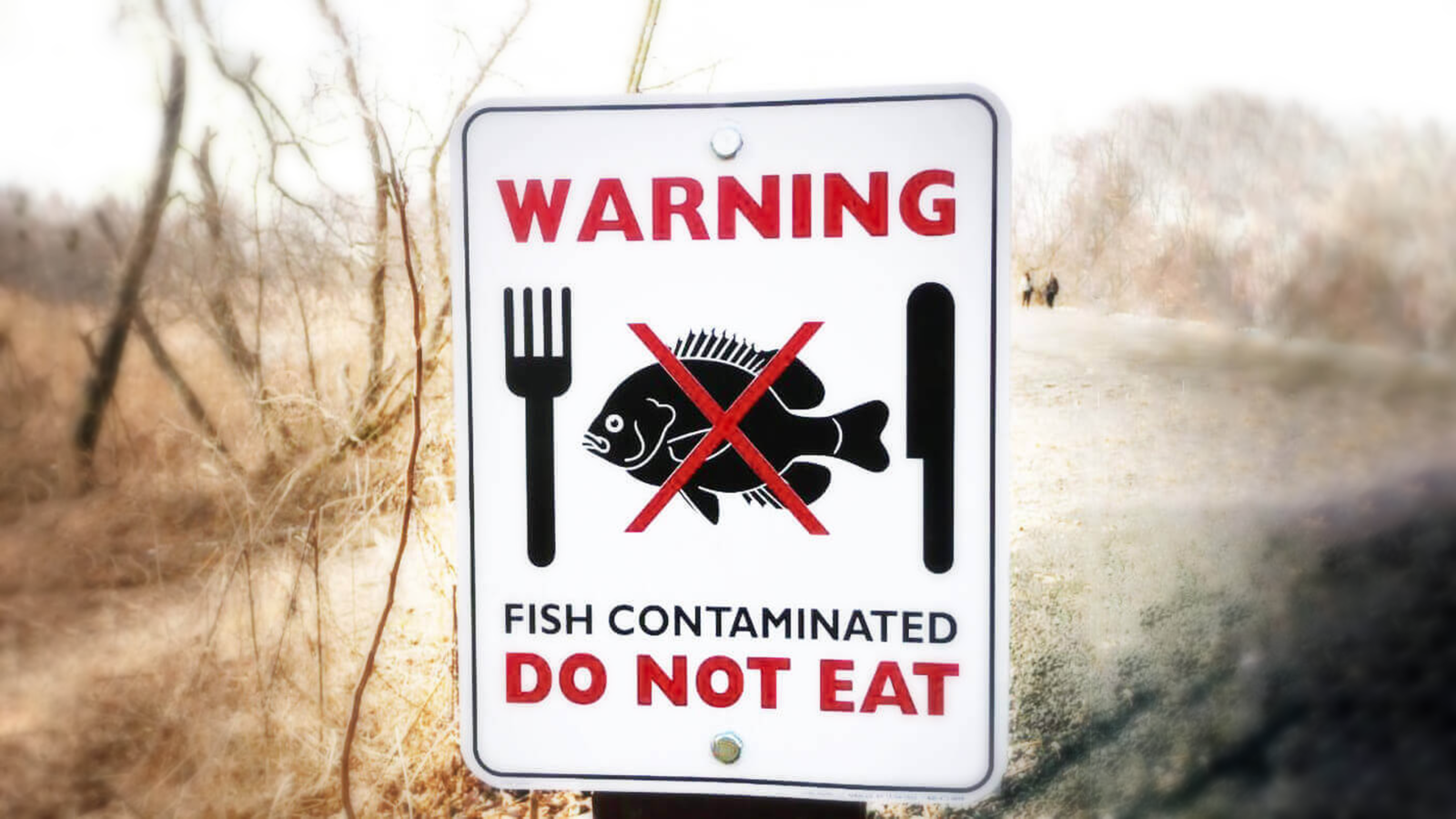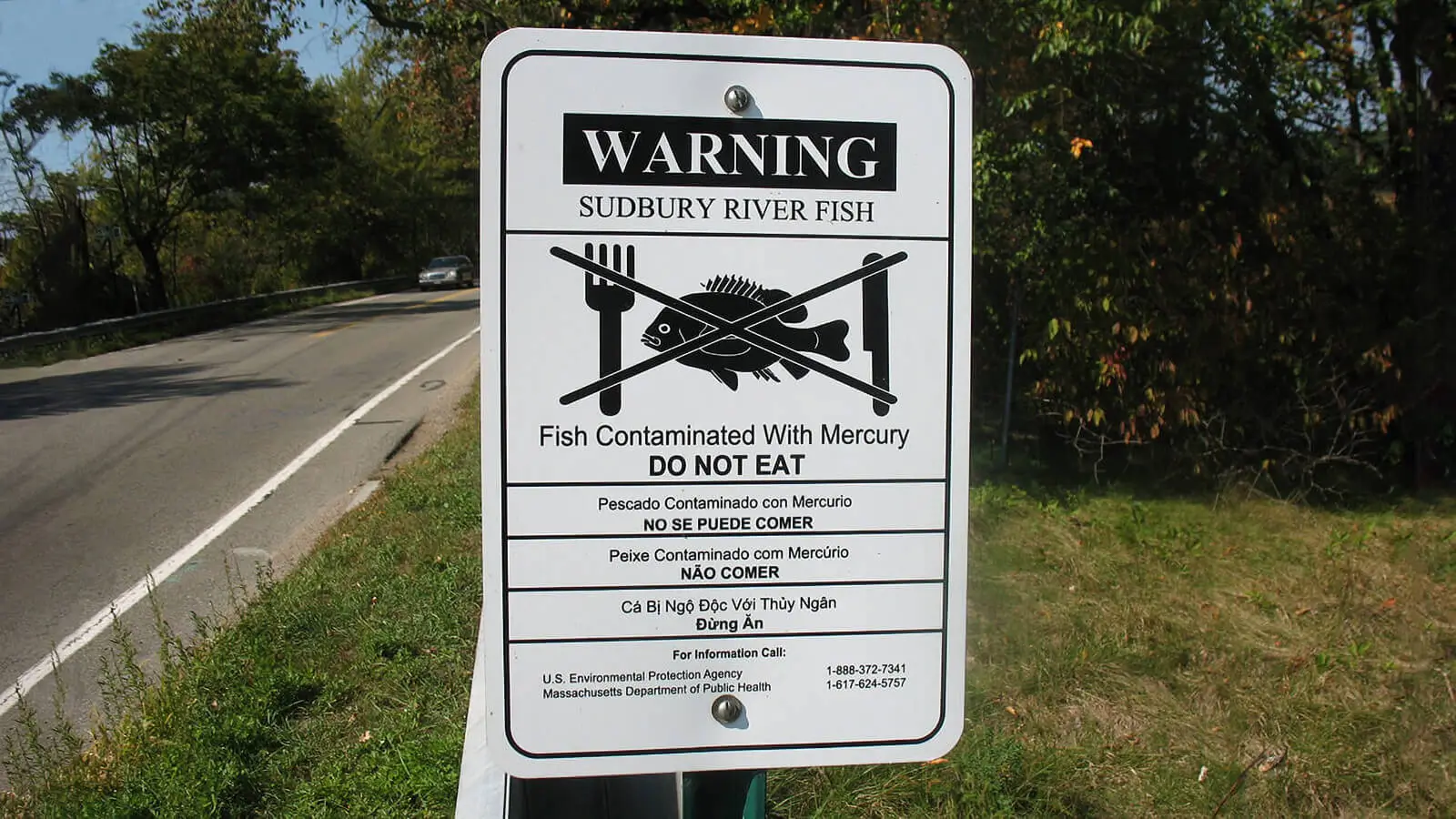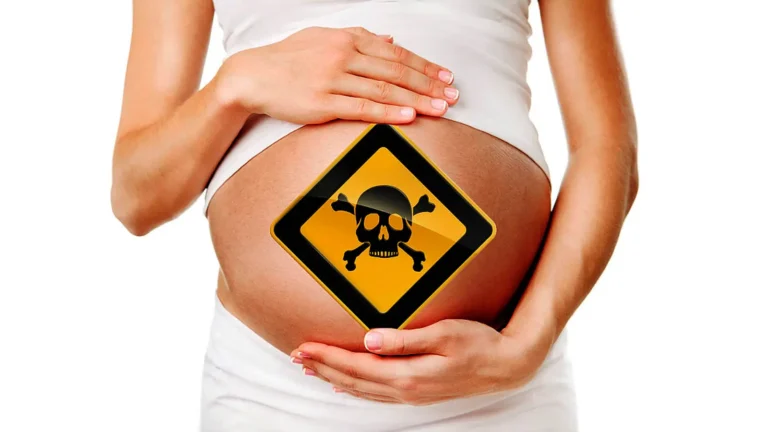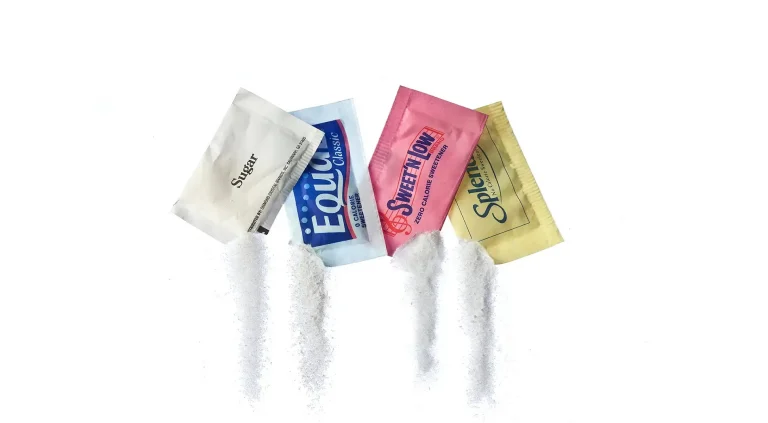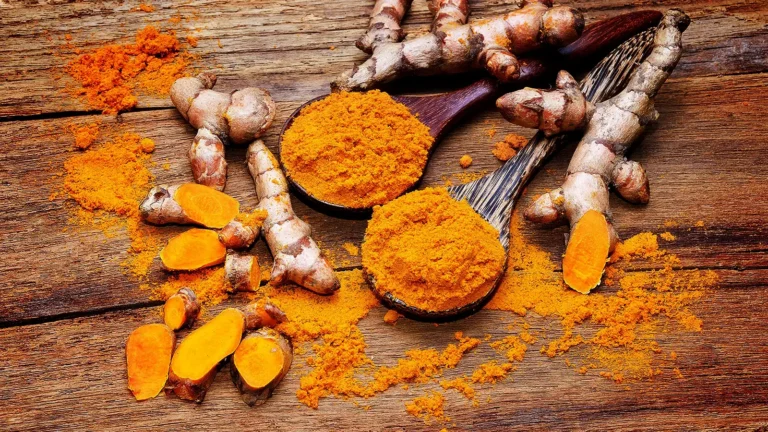Are Fish Animals? A Cultural Perspective
In some cultures, fish meat is not considered to be meat, and fish is allowed even during fast.
Milos Pokimica
Written By: Milos Pokimica
Medically Reviewed by: Dr. Xiùying Wáng, M.D.
Updated September 20, 2023Key Takeaways:
– Are Fish Animals? By every scientific definition yes, but fish are not considered to be meat by some people.
– Jews and Muslims follow kosher or halal rules that forbid eating the flesh of mammals or birds that do not have cloven hooves or chew their cud. But fish are allowed, as long as they have fins and scales.
– Hindus and Buddhists practice vegetarianism or veganism to avoid harming living beings. But they may consider fish to be less sentient than other animals, and therefore acceptable to eat.
– Jesus declared that all foods are clean and that what matters is not what goes into the mouth but what comes out of it. He also ate fish himself and used fish to feed the crowds and to symbolize his resurrection.
– The term fish is not a scientific term that describes a specific group of animals.
– There are some animals that look like fish but are actually mammals. These include whales, dolphins, porpoises, seals, sea lions, and manatees. These animals are called marine mammals because they have adapted to live in water, but they still share the features of other mammals.
– According to a study by the Wildlife Conservation Society, people in at least 114 countries have consumed one or more of at least 87 marine mammal species since 1990.
– The long-finned pilot whale has a neocortex that contains about 37.2 billion neurons and 228.1 billion glial cells, while we have only about 16.3 billion neurons and 84.6 billion glial cells in our neocortex (Mortensen et al., 2014).
– Fish can detect fear in other fish, and then become afraid too. This ability is regulated by oxytocin, the same brain chemical that underlies the capacity for empathy in humans (Akinrinade et al., 2023).
– Fish have emotional attachment to their mates, and can become pessimistic when they lose them. Scientists found that female cichlids who were separated from their preferred partners exhibited a negative affective state (Laubu et al., 2019).
– Fish have complex senses and abilities that evolved over millions of years. They can communicate, cooperate, learn, remember, and solve problems. Some fish even use tools, build nests, and recognize themselves in mirrors (Kohda et al., 2019).
– Fish have nociceptors, which are specialized nerve cells that detect harmful stimuli and send signals to the brain. Fish also have opioid receptors, which are molecules that bind to natural or synthetic substances that reduce pain sensation.
– Fish show changes in their behavior, physiology, and brain activity when exposed to painful stimuli, such as electric shocks, heat, or chemicals (Brown, 2014).
– Eating fish goes against the vegetarian principle of avoiding animal suffering and exploitation.
– Eating fish is not necessary for your health if you are a vegetarian or vegan. You can get all the essential nutrients you need from plants or supplements.
– If you are eating a plant-based diet for health reasons then it might be beneficial to add fish that is low on a food chain once a week to avoid omega 3 deficiency if you don’t want to take supplements. Seagan diet is much better than the standard American diet.
– Fish is meat and all meat contains cholesterol. The reason why doctors generally don’t advise people to lower fish consumption is because fish has omega-3 fatty acids.
– You should avoid deep-frying or adding butter or cream sauces to your fish or palm pol or any other source of saturated fat, as these methods can increase the saturated fat content of the meal and this will make your fish as bad as pork for cholesterol levels.
– Even though the levels of pollutants are minuscule when measured directly in the seawater, they can be severely toxic when measured in the top predators of the ocean. Eating these types of fish can have devastating effects on our health, such as inflammation, nerve damage, cancer, and more.
– Human-made pollution alone is enough to be a reason to never touch anything that comes out of the ocean, especially if you are pregnant or if you are a child.
What is a Fish?
Do you love eating fish? Or do you avoid it for ethical or religious reasons?
You might be surprised to learn that fish are animals, but they are not considered to be meat by some people.
Fish are part of the vertebrate group, which means they have a backbone, just like you and me. But not everyone thinks of fish as animals, or even as meat.
One reason for this is that fish are very different from other animals. They are cold-blooded, which means they do not regulate their body temperature like we do. They have scales, which cover their skin and protect them from parasites and infections. They live in water, which makes them adapt to a different environment than land animals.
Another reason is that some people have religious or personal beliefs that make them avoid eating certain types of meat, such as pork, beef, or chicken. But they may not have the same restrictions for fish.
For example, some Jews and Muslims follow kosher or halal rules that forbid eating the flesh of mammals or birds that do not have cloven hooves or chew their cud. But fish are allowed, as long as they have fins and scales. Similarly, some Hindus and Buddhists practice vegetarianism or veganism to avoid harming living beings. But they may consider fish to be less sentient than other animals, and therefore acceptable to eat.
Another reason why some people may not think of fish as animals is because they have different ways of expressing emotions and pain than mammals or birds. Fish do not have facial expressions or vocalizations that humans can easily recognize or relate to. However, this does not mean that fish do not feel anything or have no intelligence. Fish have complex nervous systems and sensory organs that allow them to respond to stimuli and interact with their environment. Fish can also learn, remember, communicate, cooperate, and solve problems.
The Bible for example has different explanations for why fish eating is allowed or not allowed by God. In the Old Testament, God gave dietary laws to the Israelites that forbade them from eating any sea creature that did not have fins or scales, such as shellfish or catfish.
In the New Testament, Jesus declared that all foods are clean and that what matters is not what goes into the mouth but what comes out of it. He also ate fish himself and used fish to feed the crowds and to symbolize his resurrection.
Some Catholics avoid eating meat on Fridays during Lent, but they can eat fish, eggs, dairy products, and other seafood. In Eastern Orthodoxy eggs, dairy products, and meat is forbidden during Lent but fish is allowed. This is because fish is considered a different kind of flesh from the land animals that were forbidden by the Bible. Some Jews also fast on several days throughout the year and abstain from all food and drink, but they can eat fish on other days when they observe a partial fast.
Therefore, the Bible does not have a single or simple explanation for fish eating. It depends on the context, the interpretation, and the personal choice of each individual.
However, from a biological perspective, fish are definitely animals. They belong to the animal kingdom, which includes all living organisms that can move, feed, grow, and reproduce. Fish also have brains, gills, fins, and other organs that make them unique and diverse. There are over 30,000 species of fish in the world, and they come in all shapes, sizes, and colors.
How are Fish Different From Other Animals?
The term fish is not a scientific term that describes a specific group of animals.
It is a common name that we use to refer to various aquatic creatures that have some similarities, but also many differences.
For example, there are bony fish, such as salmon and tuna, that have skeletons made of bone. There are cartilaginous fish, such as sharks and rays, that have skeletons made of cartilage. And there are jawless fish, such as lampreys and eels, that have no jaws or bones at all.
These different kinds of fish have different evolutionary histories and relationships with other animals. For instance, sharks and rays are more closely related to humans than they are to lampreys or eels. This is because sharks and rays belong to the same class as humans: Chondrichthyes. Lampreys and eels belong to a different class: Agnatha. Therefore, fish is a convenient term to refer to diverse aquatic organisms, but it is not a taxonomic group that would be used in a phylogenetic classification scheme.
So what does this mean for you? Well, it depends on how you view fish. Are they animals? Are they meat? Are they food? Are they friends?
The answer may vary depending on your culture, religion, ethics, preferences, and knowledge. But one thing is certain:
Fish are scientifically defined as animals and have brains and do experience pain.
Are There Mammal Fish?
Some of the animals that live in water are actually mammals, just like us. But how can you tell the difference between fish and mammals? And why does it matter?
Fish and mammals are both types of animals that have a backbone, which makes them vertebrates. But they belong to different classes of vertebrates: fish are in the classes Agnatha, Chondrichthyes, and Osteichthyes, while mammals are in the class Mammalia. These classes have different characteristics that make them unique.
For example, fish have gills, which allow them to breathe underwater. They also have scales, which cover their skin and protect them from parasites and infections. Fish are cold-blooded, which means they do not regulate their body temperature like we do. They also lay eggs, which hatch into baby fish.
On the other hand, mammals have lungs and they have mammary glands, which produce milk to feed their young. Mammals are warm-blooded, which means they can maintain a constant body temperature regardless of the environment. They also give birth to live young, which are usually fully developed and ready to survive.
There are some animals that look like fish but are actually mammals. These include whales, dolphins, porpoises, seals, sea lions, and manatees. These animals are called marine mammals because they have adapted to live in water, but they still share the features of other mammals.
For example, marine mammals breathe air through the lungs, not the gills. They have hair or fur on their bodies, not scales. And they produce milk to feed their young, not eggs. Marine mammals are also warm-blooded and give birth to live young. Some of them even have legs or flippers that help them move on land or in water.
So why is it important to know the difference between fish and mammals?
Imagine you are at a restaurant and you see a menu with dishes like whale steak, seal soup, or dolphin sushi. Would you be curious to try them?
Some people eat marine mammals for various reasons, such as food, tradition, religion, or preference. For some people, marine mammals are a source of nutrition and income. For others, they are a symbol of cultural identity and heritage. And for others, they are a matter of taste and choice. However, eating marine mammals can also have negative impacts on the environment, animal welfare, and human health.

According to a study by the Wildlife Conservation Society, people in at least 114 countries have consumed one or more of at least 87 marine mammal species since 1990.
Some of the most commonly eaten animals are small cetaceans like dolphins and porpoises. The study also found that the consumption of marine mammals is increasing in some regions, especially in Asia and Africa.
Some of the places or cultures that eat marine mammals are:
- Japan: Japan is one of the largest consumers of marine mammals in the world. It has a long history of whaling and dolphin hunting, which are considered part of its cultural heritage and culinary tradition. Japan also claims that it conducts scientific research on whales, but many critics argue that this is a cover for commercial whaling. Japan mainly eats minke whales, fin whales, and dolphins.
- Arctic: Arctic people, such as Inuit, Yupik, and Chukchi, have depended on whale meat and blubber for thousands of years. They hunt whales, seals, walruses, and polar bears for food, clothing, tools, and fuel. They also have a spiritual connection with these animals and respect them as part of their culture and identity. They mainly eat bowhead whales, beluga whales, narwhals, ringed seals, bearded seals, and harp seals.
- Canada: Canada allows the hunting of seals for subsistence and commercial purposes. The seal hunt is mainly conducted by Newfoundlanders and Labradorians, who consider it a vital source of income and food. They also argue that the seal population is abundant and needs to be controlled to protect the fish stocks. Canada mainly eats harp seals, hooded seals, and grey seals.
- Mozambique: Mozambique is one of the countries where people have recently started to eat marine mammals due to poverty and food insecurity. In April 2019, more than 100 people died after eating a dead whale that washed ashore in Cabo Delgado province. The whale was contaminated with saxitoxin, a deadly marine toxin that causes paralytic shellfish poisoning. In Mozambique, people mainly eat humpback whales.
Marine Mammals Cognition.
Who do you think is the smartest animal on Earth? You might say it’s us, humans. We have done so much with our brains, which are bigger and more advanced than most other animals.
But what if I told you that there is another animal that has a bigger and more advanced brain than us? An animal that lives in the water, not on the land. An animal that you might not even know much about. An animal that is called the long-finned pilot whale.
The long-finned pilot whale is a type of dolphin that can grow up to 6.5 meters long and weigh up to 2.3 tons. It lives in large groups called pods, which can have up to 150 members. They communicate with each other using a variety of sounds, such as clicks, whistles, and buzzes. It feeds on fish, squid, and octopus, using echolocation to find its prey.
But what makes the long-finned pilot whale so special is its brain. Its brain is huge, weighing about 5.7 kilograms, which is more than twice as much as ours. Its brain is also complex, having more neurons and glial cells than any other mammal, including us. Neurons are the cells that transmit information in the brain, while glial cells are the cells that support and protect the neurons. The neocortex is the part of the brain that is responsible for higher cognitive functions, such as learning, memory, reasoning, and language.
The long-finned pilot whale has a neocortex that contains about 37.2 billion neurons and 228.1 billion glial cells, while we have only about 16.3 billion neurons and 84.6 billion glial cells in our neocortex (Mortensen et al., 2014).
What does this mean for the intelligence of the long-finned pilot whale? Well, we don’t know for sure, because we don’t have a clear and universal way to measure intelligence across different species. However, we can assume that having more brain cells means having more processing power and potential for learning and problem-solving. We can also look at some of the behaviors that the long-finned pilot whale exhibits, which suggests that it is very smart and social.
For example, the long-finned pilot whale can learn new skills from other whales, such as how to catch certain types of fish or how to avoid predators. It can also cooperate with other whales to hunt or defend themselves from threats. It can even show empathy and altruism towards other whales or dolphins that are injured or stranded, by helping them or staying with them until they recover or die.

So, next time you think about who is the smartest animal on Earth, don’t forget about the long-finned pilot whale. It might not have arms or legs or speech like us, but it has a brain that is bigger and more complex than ours. It might not have technology like us, but it has culture and society like us. It might not be like us at all, but it is still an intelligent and sentient being that deserves our respect and protection.
Do Fish Have Emotions?
Scientists are usually reluctant to attribute humanlike feelings to animals. But it’s generally accepted that many animals have moods, including fish.
According to some recent studies, fish do have emotions and can even empathize with other fish. They can also show signs of mood, intelligence, and social needs. Here are some of the main findings from these studies:
- Fish can detect fear in other fish, and then become afraid too. This ability is regulated by oxytocin, the same brain chemical that underlies the capacity for empathy in humans (Akinrinade et al., 2023).
- Fish have emotional attachment to their mates, and can become pessimistic when they lose them. Scientists found that female cichlids who were separated from their preferred partners exhibited a negative affective state (Laubu et al., 2019).
- Fish have complex senses and abilities that evolved over millions of years. They can communicate, cooperate, learn, remember, and solve problems. Some fish even use tools, build nests, and recognize themselves in mirrors (Kohda et al., 2019).
This ability to recognize yourself in the mirror is called mirror self-recognition (MSR), and it is a sign of high-level cognition. It means that you have a sense of self, that you can distinguish yourself from others, and that you can evaluate your own state. Not many animals can do this. Only some mammals and birds, like chimpanzees, dolphins, elephants, and magpies, have shown MSR.
But what about other animals? Do they have a sense of self too? How can we test them?
The usual way to test for MSR is the mark test. This test involves putting a mark on the animal’s body that they cannot see without a mirror, and then observing if they try to remove it or touch it when they see their reflection. This would indicate that they recognize the mark as something abnormal on themselves, and not on another animal.
However, this test has some limitations. It assumes that the animal can perform certain behaviors, like contingency testing and self-directed behavior. Contingency testing means that the animal can understand that the mirror reflects their own movements and actions, not someone else’s. Self-directed behavior means that the animal can direct their attention or actions toward themselves, not just toward others. These behaviors may be hard to detect or interpret in animals that are very different from us, especially those that do not have limbs or hands to touch themselves.
This is where (Kohda et al., 2019) study comes in. Scientists tested a fish, the cleaner wrasse, which is a monogamous and cooperative species that lives in coral reefs. These fish show behavior that could be interpreted as passing the mark test.
They react to their reflection as if it were another fish, they perform unusual movements in front of the mirror, and they look at their reflection frequently. When scientists put a colored tag on their bodies and gave them a mirror, they tried to scrape off the tag by rubbing their bodies against the mirror or other objects. They did not do this when the tag was transparent or when there was no mirror.
This finding is amazing because it suggests that fish may have MSR too. But it also raises some questions. Do we accept that these fish are self-aware, based on their behavior in the mark test? Or do we think that their behavior is driven by something else, like curiosity or confusion, and that they do not have MSR? If we say yes to the first question, what does this mean for how we think about animal intelligence? If we say no to the second question, what does this mean for how we use and understand the mark test as a measure of animal cognition?
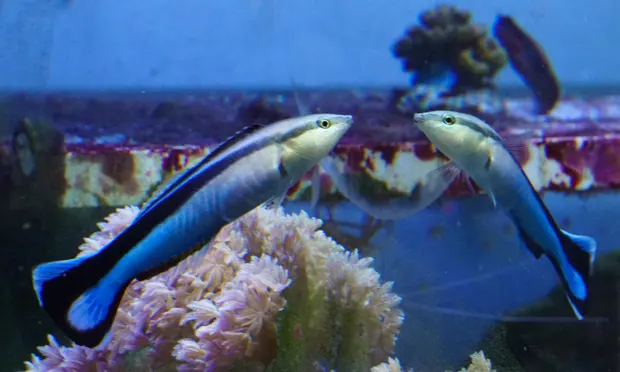
Emotional Contagion.
Emotional contagion is the most basic form of empathy, which is the ability to understand and care for the feelings of others.
Have you ever felt sad when you saw someone crying, or scared when you heard someone screaming? If so, you have experienced emotional contagion, which is the ability to share and feel the emotions of others.
In the study on zebrafish (Akinrinade et al., 2023), which are small and colorful fish that live in freshwater, scientists wanted to know what makes zebrafish feel and show emotional contagion. They focused on a hormone called oxytocin, which is known to regulate empathy and social bonding in mammals, such as humans, dogs, and mice. Oxytocin is produced by special cells in the brain and released into the bloodstream or directly into other brain regions. Oxytocin can affect how we behave and feel in different situations, such as hugging, kissing, or helping.
Zebrafish are very social animals that can form groups and communicate with each other. They can also show emotional contagion, especially when they see their friends in danger. For example, when one zebrafish is exposed to a predator or a shock, the other zebrafish nearby will also show signs of fear and stress, such as freezing, darting, or changing color.
We found that oxytocin is both necessary and sufficient for observer zebrafish to imitate the distressed behavior of conspecific demonstrators. This means that without oxytocin or its receptor, observer zebrafish did not show emotional contagion.
We also looked at the brain regions that are involved in emotional contagion in zebrafish. We found that they are similar to those involved in the same process in rodents, such as mice and rats.
This means that emotional contagion is an evolutionarily conserved phenomenon that has been present since the origin of vertebrates. This also means that emotional contagion is not unique to humans or mammals, but shared by many other animals, such as fish.
Breakups Hurt, Even if You’re a Fish.
Have you ever wondered how emotions play a role in romantic relationships? For humans, feelings are a crucial part of finding and keeping a partner, especially at the beginning of a relationship. When we pair up with someone we really like, we feel happy and satisfied, which makes us more confident and committed to our choice. Emotions can make or break a relationship, and affect how successful it will be in the long run.
But are humans the only ones who experience emotions in relationships? What about other animals that form lasting bonds and raise their offspring together?
Emotions are also important for these animals, especially when their survival and reproduction depend on how well they cooperate with their partners.
To test this idea, scientists studied a fish called the convict cichlid, which is known for its monogamy and parental care (Laubu et al., 2019). These fish form stable pairs that work together to defend their eggs and fry from predators. Scientists wanted to see how the quality of their partner affects their emotional state, and how that influences their reproductive success.
They gave female fish the choice between two males, and after females made their choice, scientists assigned them either their preferred or non-preferred partner. In some cases, the researchers split them up and paired the females with the males they’d rejected.
They found that females who got their preferred partner had more eggs and fry than those who got their non-preferred partner. This shows that partner quality matters for these fish.
But how did they feel about it? To measure their emotional state, we used a method called the judgment bias paradigm, which has been used before in other animals like birds and mammals. This method involves training the animals to associate different cues with different outcomes, and then testing how they respond to ambiguous cues.
For example, if a fish learns that a blue light means food and a red light means nothing, how will it react to a purple light? A fish that is optimistic will expect food and approach the purple light, while a fish that is pessimistic will expect nothing and avoid the purple light.
They found that females who got their non-preferred partner were more pessimistic than those who got their preferred partner. On the other hand, females who got their preferred partner did not show any change in their emotional state, which suggests that they were satisfied with their situation.
Results of this study show that pair-bonding can affect emotions not only in humans but also in other animals like fish. This implies that emotions are an evolutionary adaptation that helps animals find and keep good partners, and cooperate with them for better reproductive success.
Emotions are not just a human thing, they are a universal thing.
Can Fish Feel Pain?
Fish are one of the most diverse and widely used groups of animals by humans. We catch them from the oceans, rivers, and lakes for food and trade. We breed them in farms and tanks for consumption and entertainment. We study them in labs and aquariums for knowledge and innovation.
Unfortunately, many people tend to underestimate the intelligence and sentience of fish. They think that fish are cold-blooded, brainless, and emotionless beings who cannot feel pain or suffer. They think that fish are so different from us that they do not matter morally or ethically. But is this really true? Or is this just a convenient way to justify our exploitation and neglect of these amazing animals?
The truth is, that fish are much more than what meets the eye. They have a rich sensory world that allows them to see, hear, smell, taste, and touch their environment. They have a remarkable cognitive capacity that enables them to learn, remember, communicate, and cooperate with each other. They have a sophisticated emotional system that makes them experience joy, fear, stress, and pain. They have a unique personality that makes them individual and distinctive.
In fact, many studies have shown that fish perception and cognition often match or surpass those of other vertebrates, including mammals and birds. For example, Some fish can use tools, such as rocks or shells, to crack open hard prey items, a skill that requires problem-solving and innovation. Some fish can count, categorize, plan, and deceive, abilities that indicate higher-order thinking and reasoning.
But what about pain? Do fish feel pain like we do? This is a controversial question that has been debated for decades among scientists, philosophers, and animal advocates. Some argue that fish do not have the necessary brain structures or nerve endings to experience pain. Others claim that fish do have physiological and behavioral responses to indicate pain. The evidence for both sides is complex and inconclusive.
However, a review of the available data strongly suggests that fish do experience pain in a similar way to other vertebrates (Brown, 2014).
The review found that fish have nociceptors, which are specialized nerve cells that detect harmful stimuli and send signals to the brain. The review also found that fish have opioid receptors, which are molecules that bind to natural or synthetic substances that reduce pain sensation. The review further found that fish show changes in their behavior, physiology, and brain activity when exposed to painful stimuli, such as electric shocks, heat, or chemicals.
These findings imply that fish are not only aware of pain but also suffer from it. This means that fish are sentient beings that have a subjective experience of their existence. This also means that fish deserve our moral consideration and ethical treatment.
Unfortunately, the current laws and policies do not reflect this reality. Fish are often excluded from the legal protection and welfare standards that apply to other vertebrates. Fish are often subjected to cruel and inhumane practices in the fishing, aquaculture, research, and entertainment industries. Fish are often killed without stunning or anesthesia, causing them unnecessary agony and distress.
This is not only unethical but also unsustainable. Overfishing and pollution are threatening the survival of many fish species and ecosystems. Climate change and habitat loss are altering the natural balance of the aquatic environment. Human health and well-being are also at risk from consuming contaminated or diseased fish products.
Can Vegetarians Eat Fish?
The short answer is no.
Vegetarians do not eat any kind of animal flesh, whether it comes from land or water. Fish are animals too, and they have feelings, just like cows, pigs, and chickens.
Eating fish goes against the vegetarian principle of avoiding animal suffering and exploitation.
But wait, you might say, what about those people who eat fish but not meat? Are they not vegetarians too? Actually, they are not.
They have a different name: pescatarians.
Pescatarians are people who follow a mostly vegetarian diet but occasionally eat fish and seafood. They may have different reasons for doing so, such as enjoying the taste or getting health benefits.
However, eating fish is not necessary for your health if you are a vegetarian or vegan. You can get all the essential nutrients you need from plants or supplements.
For instance, fish and seafood are known to be high in protein, omega-3 fatty acids, zinc, and vitamin B12.
You can also get omega-3 from plant sources such as algae-based DHA supplements and for zinc and B12 chlorella is an excellent source for both of them. You can read more about chlorella in this article Chlorella Benefits: Essential Guide.
Seagan Vs Pescatarian.
The term seaganism was coined by Sana, a nutritionist and wellness expert, who explains that it means “when you couple a vegan diet with fish and seafood.” This diet has become especially popular following the rise of veganism, which has attracted many people for its environmental and ethical appeal.
However, veganism is not without its challenges, especially when it comes to getting enough protein and omega-3 fatty acids, which are essential for our health.
You might be wondering how the seagan diet is different from being pescatarian, which is another popular way of eating that includes fish and seafood, but not meat or poultry. The main difference is that seaganism does not feature dairy products – so eggs, milk, and cheese are all off the shopping list.
This means that seagans rely on plant-based sources of calcium, such as leafy greens, nuts, seeds, and fortified plant milk. They also avoid animal-derived products such as honey, gelatin, and leather.
Another difference is that seagans are very careful about choosing sustainably sourced fish and seafood, to minimize their environmental impact and ensure animal welfare. They avoid overfished species, such as cod, tuna, and swordfish, and opt for smaller fish that are lower in the food chain, such as sardines, anchovies, and mackerel.
What are the health benefits of a seagan diet? One of the main reasons why people choose the seagan diet is because of its health benefits. By eating a plant-based diet with fish and seafood a few times a week, seagans can enjoy the best of both worlds: the vitamins, minerals, antioxidants, and fiber from plants, and the protein, omega-3s, vitamin B-12, and vitamin D from fish.
The other option is to just use supplements. However, this type of diet is more palatable for people who do not want to eat a whole full vegan diet and are not into veganism for philosophical but more for health reasons.
If you are eating a plant-based diet for health reasons then it might be beneficial to add fish that is low on a food chain once a week to avoid omega 3 deficiency if you don’t want to take supplements. This diet is much better than the standard American diet.
Seagans can benefit from the lower intake of saturated fat and cholesterol that comes from avoiding meat and dairy products. This can help lower blood pressure and cholesterol levels, and improve blood sugar control.
However, there is one big however here. It is only better for your health if you eat fish no more than once a week. Eating fish every day will negate most of the benefits of a plant-based diet.
Fish and Cholesterol.
Fish is meat and all meat contains cholesterol. The reason why doctors generally don’t advise people to lower fish consumption is because fish has omega-3 fatty acids.
The argument goes that although all fish contain cholesterol, they are low in saturated fat, which is the main dietary culprit for raising LDL (bad) cholesterol levels. Some fish also contain omega-3 fatty acids, which can help lower your triglyceride levels and increase your HDL (good) cholesterol levels. Omega-3s are essential for your health and can protect you from cardiovascular diseases. The problem is that you can get omega 3 from algae-based DHA supplements and you don’t need fish.
Different kinds of fish have different amounts of cholesterol and omega-3s. For example, salmon, herring, mackerel, and sardines are high in omega-3s and low in cholesterol. Shellfish such as shrimp, lobster, crab, and oysters are high in cholesterol but also contain some omega-3s. Squid has the highest cholesterol content among seafood.
You should avoid deep-frying or adding butter or cream sauces to your fish or palm pol or any other source of saturated fat, as these methods can increase the saturated fat content of the meal and this will make your fish as bad as pork for cholesterol levels. This would add saturated fat to already existing cholesterol in fish. Instead, you can broil, bake, grill, or steam your fish and season it with herbs, spices, lemon juice, or vinegar.
| Seafood (raw, 3.5 oz portions) | Total cholesterol (mg) | Omega-3 fatty acids (grams) |
| Lobster | 71-95 | 0.1 |
| Salmon | 63-74 | 2.6 |
| Oysters | 55 | 0.7 |
| Crab | 52 | 0.4 |
| Halibut | 41 | 0.6 |
| Tuna | 30-48 | 0.2-1.5 |
| Sardines | 142 | 1.2 |
| Squid | 231 | 0.4 |
| Shrimp | 194 | 0.32 |
Fish Toxicity.
Imagine a glass of water with a drop of poison in it. Would you drink it? Probably not. Now imagine that same drop of poison being diluted in a large bucket of water. Would you drink it then? Maybe you would, thinking that the poison is too diluted to harm you. But what if you were not the only one drinking from that bucket? What if there were millions of tiny creatures that also drank from it, and then became your food? That’s what’s happening in our oceans right now.
Every day, tons of pollution from factories, farms, cities, and other sources are washed away by rain and rivers, and end up in the ocean. Some of these pollutants are biodegradable, meaning they can be broken down by natural processes. But others are persistent, meaning they stay in the ocean for a long time, creating a serious problem for marine life.
You see, even though the concentration of these pollutants in the ocean is low, they don’t just disappear. They are absorbed by plankton and algae, the tiny organisms that form the base of the marine food chain. These organisms filter the water to get their nutrients, but they also end up ingesting the pollutants along with them. This is called bioaccumulation, the process by which toxins accumulate in living organisms.
But it doesn’t stop there. When bigger animals, such as fish, eat these plankton and algae, they also eat the toxins that they have accumulated. And when even bigger animals, such as sharks, dolphins, or humans, eat these fish, they also eat the toxins that they have accumulated. This is called biomagnification, the process by which toxins increase in concentration as they move up the food chain.
The result is that even though the levels of pollutants are minuscule when measured directly in the seawater, they can be severely toxic when measured in the top predators of the ocean. Eating these types of fish can have devastating effects on our health, such as inflammation, nerve damage, cancer, and more.
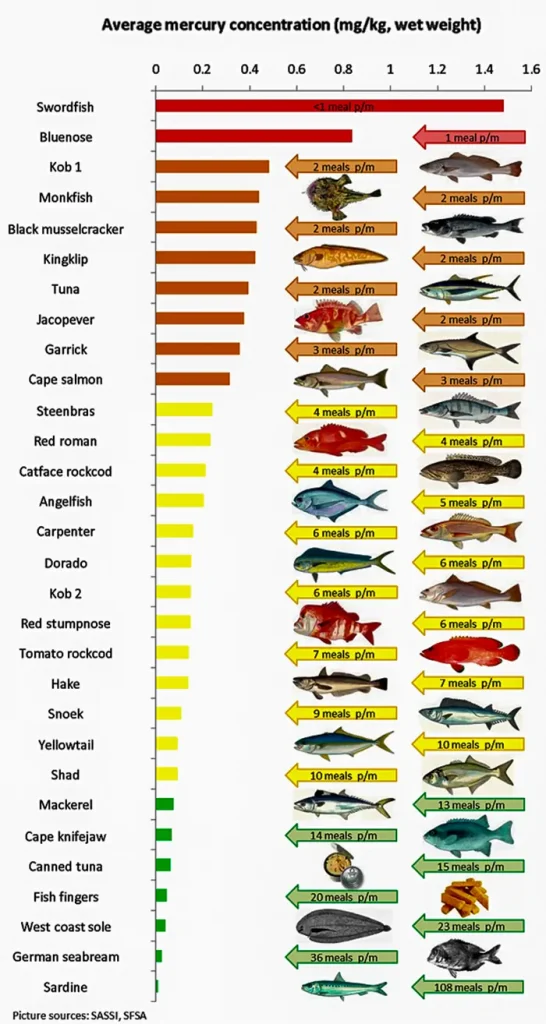
You might think that fish is a healthy meat source, rich in protein and omega-3 fatty acids. But the truth is that fish is everything except healthy. The pollution today is so great that even if we ignore all of the other bad effects of meat consumption that I have analyzed in other articles books and topics, human-made pollution alone is enough to be a reason to never touch anything that comes out of the ocean, especially if you are pregnant or if you are a child.
So what can we do to protect ourselves and our oceans from this threat? We can start by reducing our consumption of fish and seafood or avoiding them altogether. We can also choose fish that are lower in the food chain and less likely to be contaminated, such as sardines or anchovies. We can also support environmental organizations that work to prevent and clean up ocean pollution. And we can educate ourselves and others about the dangers of ocean pollution and how to prevent it.
You can read more about fish toxicity in these articles Fish Toxicity- The Most Toxic Meat and Farmed Fish- “Cesspool” Paradise.
FAQ
References:
- Akinrinade, I., Kareklas, K., Teles, M., Reis, T. K., Gliksberg, M., Petri, G., Levkowitz, G., & Oliveira, R. F. (2023). Evolutionarily conserved role of oxytocin in social fear contagion in zebrafish. Science, 379(6638), 1232–1237. https://doi.org/10.1126/science.abq5158
- Laubu, C., Louâpre, P., & Dechaume-Moncharmont, F. (2019b). Pair-bonding influences affective state in a monogamous fish species. Proceedings of the Royal Society B: Biological Sciences, 286(1904), 20190760. https://doi.org/10.1098/rspb.2019.0760
- Kohda, M., Hotta, T., Takeyama, T., Awata, S., Tanaka, H., Asai, J., & Jordan, L. A. (2019). If a fish can pass the mark test, what are the implications for consciousness and self-awareness testing in animals? PLOS Biology, 17(2), e3000021. https://doi.org/10.1371/journal.pbio.3000021
- Brown, C. (2014). Fish intelligence, sentience and ethics. Animal Cognition, 18(1), 1–17. https://doi.org/10.1007/s10071-014-0761-0
- Mortensen, H. S., Pakkenberg, B., Dam, M., Dietz, R., Sonne, C., Mikkelsen, B., & Eriksen, N. (2014). Quantitative relationships in delphinid neocortex. Frontiers in neuroanatomy, 8, 132. https://doi.org/10.3389/fnana.2014.00132
Do you have any questions about nutrition and health?
I would love to hear from you and answer them in my next post. I appreciate your input and opinion and I look forward to hearing from you soon. I also invite you to follow us on Facebook, Instagram, and Pinterest for more diet, nutrition, and health content. You can leave a comment there and connect with other health enthusiasts, share your tips and experiences, and get support and encouragement from our team and community.
I hope that this post was informative and enjoyable for you and that you are prepared to apply the insights you learned. If you found this post helpful, please share it with your friends and family who might also benefit from it. You never know who might need some guidance and support on their health journey.
– You Might Also Like –

Learn About Nutrition
Milos Pokimica is a doctor of natural medicine, clinical nutritionist, medical health and nutrition writer, and nutritional science advisor. Author of the book series Go Vegan? Review of Science, he also operates the natural health website GoVeganWay.com
Medical Disclaimer
GoVeganWay.com brings you reviews of the latest nutrition and health-related research. The information provided represents the personal opinion of the author and is not intended nor implied to be a substitute for professional medical advice, diagnosis, or treatment. The information provided is for informational purposes only and is not intended to serve as a substitute for the consultation, diagnosis, and/or medical treatment of a qualified physician or healthcare provider.NEVER DISREGARD PROFESSIONAL MEDICAL ADVICE OR DELAY SEEKING MEDICAL TREATMENT BECAUSE OF SOMETHING YOU HAVE READ ON OR ACCESSED THROUGH GoVeganWay.com
NEVER APPLY ANY LIFESTYLE CHANGES OR ANY CHANGES AT ALL AS A CONSEQUENCE OF SOMETHING YOU HAVE READ IN GoVeganWay.com BEFORE CONSULTING LICENCED MEDICAL PRACTITIONER.
In the event of a medical emergency, call a doctor or 911 immediately. GoVeganWay.com does not recommend or endorse any specific groups, organizations, tests, physicians, products, procedures, opinions, or other information that may be mentioned inside.
Editor Picks –
Milos Pokimica is a health and nutrition writer and nutritional science advisor. Author of the book series Go Vegan? Review of Science, he also operates the natural health website GoVeganWay.com
Latest Articles –
Top Health News — ScienceDaily
- MIT scientists strip cancer of its sugar shieldon December 23, 2025
Scientists at MIT and Stanford have unveiled a promising new way to help the immune system recognize and attack cancer cells more effectively. Their strategy targets a hidden “off switch” that tumors use to stay invisible to immune defenses—special sugar molecules on the cancer cell surface that suppress immune activity. Early tests show it can supercharge immune responses and outperform current antibody therapies.
- Scientists find a weak spot in deadly fungus that shut down hospital intensive care unitson December 23, 2025
A deadly hospital fungus that resists nearly every antifungal drug may have an unexpected weakness. Researchers discovered that Candida auris activates specific genes during infection to hunt for nutrients it needs to survive. This insight came from a new living-host model that allowed scientists to watch the fungus in action. The findings could eventually lead to new treatments or allow current drugs to be repurposed.
- This ultra-sensitive imaging system can spot cancer earlieron December 23, 2025
A new imaging technology can distinguish cancerous tissue from healthy cells by detecting ultra-weak light signals. It relies on nanoparticles that bind to tumor markers, making cancerous areas easier to identify. The system is far more sensitive than existing tools and could speed up cancer screening. Scientists believe it may help detect tumors earlier and reduce delays in diagnosis.
- Hidden brain maps that make empathy feel physicalon December 23, 2025
When we watch someone move, get injured, or express emotion, our brain doesn’t just see it—it partially feels it. Researchers found eight body-like maps in the visual cortex that organize what we see in the same way the brain organizes touch. These maps help us instantly understand actions, emotions, and intentions in others. The discovery sheds light on human empathy and opens doors for new brain-based therapies and AI systems that better understand the body.
- Are they really listening? Watch their blinkson December 23, 2025
Your eyes may reveal when your brain is working overtime. Researchers found that people blink less when trying to understand speech in noisy environments, especially during the most important moments. The effect stayed the same in bright or dark rooms, showing it’s driven by mental effort, not light. Blinking, it turns out, is a quiet marker of focused listening.
- This cancer-fighting molecule took 50 years to buildon December 22, 2025
MIT scientists have achieved the first-ever lab synthesis of verticillin A, a complex fungal compound discovered in 1970. Its delicate structure stalled chemists for decades, despite differing from related molecules by only two atoms. With the synthesis finally complete, researchers created new variants that showed strong activity against a rare pediatric brain cancer. The breakthrough could unlock an entire class of previously unreachable cancer-fighting molecules.
- A new drug could stop Alzheimer’s before memory loss beginson December 22, 2025
New research suggests Alzheimer’s may start far earlier than previously thought, driven by a hidden toxic protein in the brain. Scientists found that an experimental drug, NU-9, blocks this early damage in mice and reduces inflammation linked to disease progression. The treatment was given before symptoms appeared, targeting the disease at its earliest stage. Researchers say this approach could reshape how Alzheimer’s is prevented and treated.
PubMed, #vegan-diet –
- Comparing diet-related attitudes, perceptions, and behaviors of vegan and omnivorous adults: results from a cross-sectional survey study in Germanyon December 22, 2025
CONCLUSION: The findings are consistent with and build on existing research on cognitive and behavioral patterns related to a vegan diet, while at the same time yielding some additional insights. In particular, the results on significant differences in the risk-benefit perception of a vegan diet, as well as on motivations and influences regarding the decision to follow a vegan diet provide an important basis for the development of public health interventions and a foundation for further […]
- Assessment of vitamin A, vitamin B2, vitamin B12, vitamin K, folate, and choline status following 4 months of multinutrient supplementation in healthy vegans: a randomised,…on December 19, 2025
CONCLUSION: A multinutrient supplement containing 82 µg of vitamin B(12) per day significantly positively affected vitamin B(12) blood biomarkers in healthy vegans.
- Exploring the synergistic potential of pH and ultrasonication on the functional properties of pea and lentil protein isolates and its formulation in food producton December 15, 2025
The substitution of meat proteins with plant-based proteins from various sources is often motivated by nutritional considerations. However, the inherent limited solubility of plant proteins, which results in suboptimal techno-functional properties, remains a persistent challenge in food formulation. The purpose of this study was to utilize unique properties of pea (Pisum sativum L.) and lentil (Lens culinaris) through ultrasonication and pH variation in order to develop a stable and […]
- Healthful and Unhealthful Plant-Based Diets and Their Association with Cardiometabolic Targets in Women Diagnosed with Breast Cancer: A Cross-Sectional Analysis of a Lifestyle Trialon December 11, 2025
CONCLUSIONS: Maintaining cardiometabolic risk factors within normal ranges is clinically relevant in BCS, and this may be more likely when a plant-based diet is consumed, especially if low in unhealthy plant foods.
- Functional and Nutritional Properties of Lion’s Mane Mushrooms in Oat-Based Desserts for Dysphagia and Healthy Ageingon December 11, 2025
Hericium erinaceus (Lion’s Mane mushroom) is a medicinal species recognised for its neuroprotective and antioxidant properties. This study investigated its potential as a functional ingredient in oat milk-based desserts formulated for individuals with dysphagia. Freeze-dried Lion’s Mane powder (LMP), containing high-quality protein (~16%, amino acid score 88%), dietary fibre (~31%), and phenolic compounds (72.15 mg GAE/g), was incorporated at varying levels using gelatin or iota-carrageenan […]
Random Posts –
Featured Posts –
Latest from PubMed, #plant-based diet –
- Associations Between Healthy and Plant-Based Dietary Patterns and Cognitive Reserve: A Cross-Sectional Analysis of the 1946 British Birth Cohortby Kelly C Cara on December 23, 2025
CONCLUSIONS: CR was positively associated with healthy dietary patterns and inversely associated with unhealthful plant-based dietary patterns. Diet uniquely explained variations in CR and should be considered among influential lifestyle factors in future research. Longitudinal analyses are needed to confirm these findings.
- Patient-Reported Observance of a Mediterranean Diet and Physical Activity in Patients Living with Breast Cancer: Implications for Primary Care Providersby Lydia Hesseltine on December 23, 2025
CONCLUSION: The majority of patients living with breast cancer did not meet the minimal national recommendations. These findings underscore the need for further research to develop strategies to optimize nutrition and physical activity within oncology and primary care settings.
- Dietary Hydrilla verticillata extract enhances growth and immune defense against Aeromonas hydrophila in Labeo rohitaby Faiza Khanam on December 23, 2025
This study investigated the effects of dietary Hydrilla verticillata extract (HVE) on growth performance, physiological responses, and disease resistance in Labeo rohita fingerlings subjected to Aeromonas hydrophila challenge. Following acclimatization, the fish were divided into 15 tanks at random (30 fish per tank) and given five different diets that contained 0, 75, 150, 300, or 600 mg/kg HVE for 60 days. Growth was significantly (P
- Dietary quercetagetin attenuates H2O2-induced oxidative damage and preserves meat quality in broilers by modulating redox status and Nrf2/ferroptosis signaling pathwayby Wenyue Hu on December 22, 2025
In modern poultry production, oxidative stress has emerged as a pivotal factor compromising the health status and overall performance of broiler. The aim of this study was to investigate the effects of dietary quercetagetin (QG) supplementation on hydrogen peroxide (H(2)O(2))-induced oxidative damage in breast muscle of broilers, focusing on growth performance, meat quality, and antioxidant function, and elucidating the underlying mechanisms. Two hundred and forty one-day-old Cobb broilers […]
- Effects of dietary selenium supplementation on physiological parameters, tissue fatty acid composition, and fatty acid-metabolism relative gene expression of grouper (Epinephelus coioides) fed high…by Yen-Chun Lee on December 22, 2025
The present study evaluated the effects of dietary selenium (Se) supplementation on growth performance, physiological responses, tissue fatty acid profiles, and the expression of genes related to fatty acid metabolism in juvenile grouper (Epinephelus coioides). A control diet based on soy protein concentrate, replacing 40% of the fish meal protein, was supplemented with graded levels of Se at 0, 0.3, 0.6, and 1.0 mg Se kg^(-1). A fish meal-based reference diet was also included for […]
- Unravelling the interaction between feeding regimens and milking time in Parmigiano Reggiano PDO milk: an integrated metabolomics and ion mobility lipidomics approachby Pier Paolo Becchi on December 22, 2025
In this study, an integrated approach based on UHPLC-HRMS metabolomics and IM-HRMS lipidomics has been carried out to unravel the interaction between feeding and milking time in the overall chemical profile of Parmigiano Reggiano (PR) milk. Specifically, ANOVA multiblock OPLS (AMOPLS) modelling revealed the complementarity of the assays in combining the effect of these two critical parameters. In particular, metabolomics highlighted the presence of plant-derived compounds (mainly terpenoids […]

